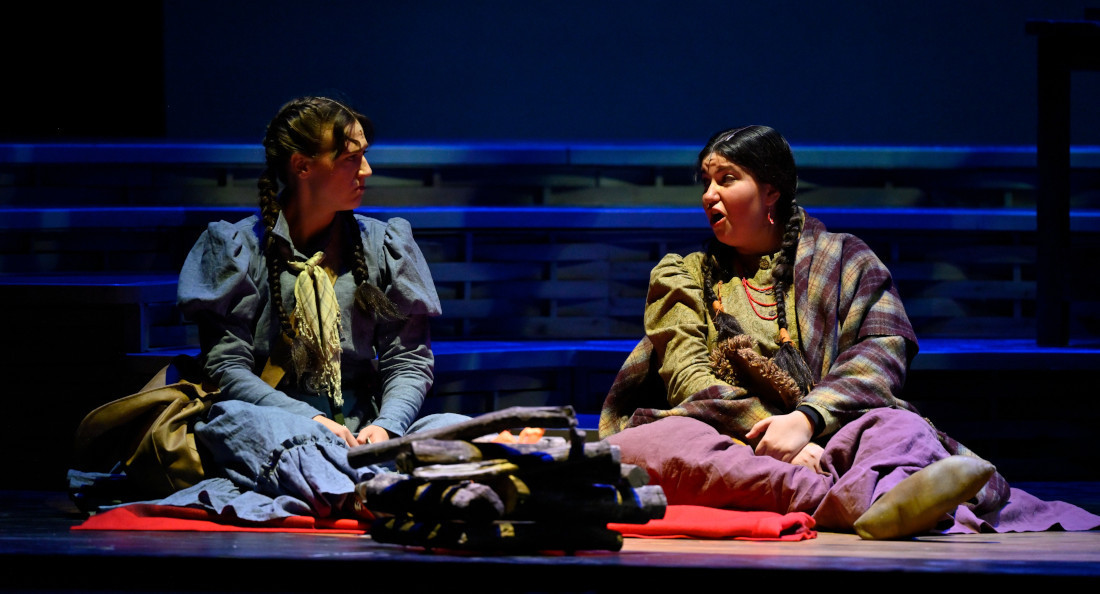Weaving Métis stories through song
Li Keur premieres as first full-scale Indigenous opera in Canada
Six years ago, during a 10,000-kilometre research trip across the M.tis homeland, Dr. Suzanne Steele, a M.tis librettist, poet and scholar, came across a historical love affair that would define her artistic life for the next several years.
While in North Dakota with composer Neil Weisensel and M.tis composer/fiddler Alex Kusturok, Steele picked up a diary believed to chronicle the life of Louis Riel in the 1870s.
“In the middle of that diary, there was a love affair that nobody had ever spoken of,” Steele says. “I just thought, ‘okay, there’s my opera.’”
From there came Li Keur: Riel’s Heart of the North, a fictionalized operatic account of Riel’s love affair. Presented by the Manitoba Opera, it follows 21st-century Joséphine-Marie (Charlene Van Buekenhout), who is transported into her ancestor Josette’s (Rebecca Cuddy) hidden romance with Louis Riel (Evan Korbut).
The show became the first full-scale Indigenous-led opera on a Canadian mainstage when it premiered at the Centennial Concert Hall on Nov. 18. It also played on Nov. 22 and will close on Nov. 24.
It’s both a rich work of Métis historical fiction and a concerted effort to revitalize Indigenous languages.
“Women are very central to this,” Steele says. “In this opera, you’re going to see a lot of beadwork. You’re going to see a lot of the women literally sewing and figuratively sewing the culture together.”
The opera, which is sung in Anishinaabemowin, Southern Michif, French Michif, English and French, features a cast of predominantly Indigenous vocalists.
For many in the cast, like Oji-Cree vocalist Keely McPeek, it’s their first time performing with the Manitoba Opera. Prior to Li Keur, most of the operas McPeek performed in were English, French, German and Italian.
But to play Marie Serpente, an Anishinaabe medicine woman fluent in three Indigenous languages, McPeek had to change her usual rehearsal repertoire of reading dictionaries, reviewing tutorials and listening to past performances.
“For this show, they made a database online. They had a bunch of language-keepers translate the works, so they have the recordings of all of the language-keepers speaking every line in the show,” McPeek says. “I just kind of had to listen to them over and over again to see how they say it and to copy them.”
The database, which was funded by a federal Social Sciences and Humanities Research Council grant, features audio and video recordings by dozens of language-keepers like Donna Beach and Debra Beach Ducharme. Steele and Weisensel compiled it ahead of the production to assist cast members with their lines while supporting Indigenous language revitalization.
As she reflects on Li Keur’s historical precedence, Steele wonders why it took so long to bring Indigenous stories to a mainstream opera company.
“Structurally, the classical music world really has a lot to learn as far as understanding different worldviews,” she says. “However, Larry Desroches, the CEO of Manitoba Opera, I think is a tremendous human being, and I’ve seen him really try to understand what it means to ‘decolonize.’”
Now, as three Indigenous languages are sung on a concert-hall stage, Steele is confident that Li Keur will be a first, but not a last.
Li Keur plays at the Centennial Concert Hall on Nov. 18, 22 and 24. To purchase tickets, visit bit.ly/3ujeFhv.
Published in Volume 78, Number 11 of The Uniter (November 23, 2023)






